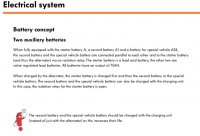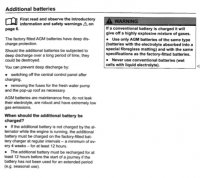I wonder how accurate the control panels are.
The Control Panels measure the current draw and voltage and compute the % capacity. Iy is not highly accurate.
Periodic Mains Charging is required to Prolong the life of the Leisure Batteries by reducing and treating the Sulphation that can occur in Lead Acid type batteries that don't get charged to their fullest capacity. That happens on the California if you only use engine charging.
A little reading.
Sulfation and How to Prevent it
Applying ways to minimize sulfation.
Sulfation occurs when a lead acid battery is deprived of a full charge. This is common with starter batteries in cars driven in the city with load-hungry accessories. A motor in idle or at low speed cannot charge the battery sufficiently.
Electric wheelchairs have a similar problem in that the users might not charge the battery long enough. An 8-hour charge during the night when the chair is not being used is not enough. Lead acid must periodically be charged 14–16 hours to attain full saturation. This may be the reason why wheelchair batteries last only 2 years, whereas golf cars with the identical battery deliver twice the service life. Long leisure time allows golf car batteries to get a full charge overnight.
Solar cells and wind turbines do not always provide sufficient charge for lead acid banks, which can lead to sulfation. This happens in remote parts of the world where villagers draw generous amounts of electricity with insufficient renewable resources to charge the batteries. The result is a short battery life. Only a periodic fully saturated charge can solve the problem. But without an electrical grid at their disposal, this is almost impossible.
An alternative solution is using lithium-ion, a battery that prefers a partial charge to a full charge. However, Li-ion is more than double the cost of lead acid. Although more expensive, the cycle count is said to be cheaper than that of lead acid because of the extended service life.
What is sulfation? During use, small sulfate crystals form, but these are normal and are not harmful. During prolonged charge deprivation, however, the amorphous lead sulfate converts to a stable crystalline and deposits on the negative plates. This leads to the development of large crystals that reduce the battery’s active material, which is responsible for the performance.
There are two types of sulfation: reversible (or soft sulfation), and permanent (or hard sulfation). If a battery is serviced early, reversible sulfation can often be corrected by applying an overcharge to an already fully charged battery in the form of a regulated current of about 200mA. The battery terminal voltage is allowed to rise to between 2.50 and 2.66V/cell (15 and 16V on a 12V mono block) for about 24 hours. Increasing the battery temperature to 50–60°C (122–140°F) during the corrective service further helps in dissolving the crystals.
Permanent sulfation sets in when the battery has been in a low state-of-charge for weeks or months. At this stage, no form of restoration seems possible; however, the recovery yield is not fully understood. To everyone’s amazement, new lead acid batteries can often be fully restored after dwelling in a low-voltage condition for many weeks. Other factors may play a role.
A subtle indication whether lead acid can be recovered or not is visible on the voltage discharge curve. If a fully charged battery retains a stable voltage profile on discharge, chances of reactivation are better than if the voltage drops rapidly with load.
Several companies offer anti-sulfation devices that apply pulses to the battery terminals to prevent and reverse sulfation. Such technologies will lower the sulfation on a healthy battery, but they cannot effectively reverse the condition once present. It’s a “one size fits all” approach and the method is unscientific.
Applying random pulses or blindly inducing an overcharge can harm the battery by promoting grid corrosion. There are no simple methods to measure sulfation, nor are commercial chargers available that apply a calculated overcharge to dissolve the crystals. As with medicine, the most effective remedy is to apply a corrective service for the time needed and not longer.
While anti-sulfation devices can reverse the condition, some battery manufacturers do not recommend the treatment as it tends to create soft shorts that may increase
self-discharge. Furthermore, the pulses contain ripple voltage that causes some heating of the battery. Battery manufacturers specify the allowable ripple when charging lead acid batteries.

















